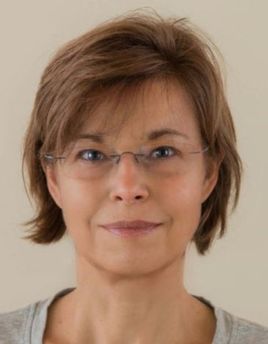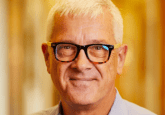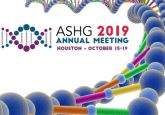Andrea Gaedigk on pharmacogenomics and the PharmVar resource

At this year’s annual meeting of the American Society for Human Genetics (ASHG 2019; 15-19 October; Houston, TX, USA), we caught up with Andrea Gaedigk to discuss her work in pharmacogenomics and developing the Pharmacogene Variation Consortium.
Can you please introduce yourself and your institution?
 My name is Andrea Gaedigk and I am the principal investigator of the Pharmacogene Variation Consortium, in short – PharmVar. I am based at the Children’s Mercy Hospital in Kansas City (MO, USA) which houses the PharmVar resource.
My name is Andrea Gaedigk and I am the principal investigator of the Pharmacogene Variation Consortium, in short – PharmVar. I am based at the Children’s Mercy Hospital in Kansas City (MO, USA) which houses the PharmVar resource.
Can you tell us about your session and presentation at ASHG?
The session I was presenting in focused on pharmacogenomics from different standpoints. One part of the presentation demonstrated the impact of a particular gene called NUDT15 on the treatment of Acute Lymphoblastic Leukemia in children and highlighted how important it is to know about genetic variation in that particular gene, as well as a second gene called TPMT, in order to avoid the severe toxicities that can happen when you treat these children. You want to help them to beat their cancer with pharmacotherapy, but sometimes you make them even sicker by administering a type of chemotherapy that causes an adverse reaction in the child. Knowing about genetic variation helps you to avoid these severe toxicities upfront by tailoring the amount of drug you give them so that they can tolerate it better.
My presentation focused on my work with PharmVar; this is providing a system to systematically catalog genetic variation in pharmacogenes, which helps to define them. These definitions are then taken up by different resources, for example the Clinical Pharmacogenetic Implementation Consortium – in short: the CPIC – which use that information to write guidelines based on how a genotype results in a specific phenotype to provide physicians with recommendations on whether a person with a certain phenotype should, or should not, take a particular drug or whether dose should be adjusted to maximize treatment success. Content provided by PharmVar is also incorporated with that provided by the Pharmacogenomics Knowledgebase, or PharmGKB which offers a tremendous wealth of curated information.
The final two presentations concerned pharmacogenomics from a genetic counselor’s perspective and the perspective of institutions implementing pharmacogenetics into clinical practice.
What challenges did you face when you were first producing PharmVar?
One challenge, always, is having enough manpower to curate all of the information and to build new database features. When you go to the PharmVar webpage you can access all the information at your fingertips. The amount of effort going into a database is often something people don’t realize – it can be very time-consuming to produce, process and display data. One particular challenge with PharmVar, and in pharmacogenomics in general, is the provision of functions to genetic variants. For some of those variants, or star alleles as we call them, the function is very well known as these were studied in patients, but there are also variants for which there is very limited, or no information at all. We continue to find variants by sequencing, but more often than not we can’t predict if it causes a meaningful change in function in an individual and even if function was measured in vitro, you always need to be careful extrapolating this to the patient.
Just as it is a challenge with genetics in general, there is so much information but we often just don’t yet know what it means for a patient. We definitely need more studies to systematically evaluate function for these variants to better inform drug therapy.
Have you enjoyed the conference so far and what you looking forward to that is yet to come?
This is a large conference with so many different topics in genetics. What I enjoy most is learning about something new, something I don’t do on a daily basis. One session I have really enjoyed discussed the use of DNA in criminal investigations. This contained fascinating stories about how DNA can be used to catch offenders by reverse engineering family relationships. We all agree that this specific use is a good thing, but it also brings up a lot of questions about how DNA should be used and highlights that some people are afraid of having genetic tests and worry that their DNA may be misused. That was a very interesting session.
Then, of course, meeting people in my field who I may only see at this conference. Although I may be communicating with someone often through email or teleconferences, it is always great to speak to collaborators face to face and have a discussion. That human contact and scientific exchange is highly valuable and cannot be replaced by electronic media.
What is your dream for the impact of PharmVar in the next five years?
In pharmacogenomics, we all dream about the field being implemented on a much broader level to help optimize drug therapy for patients, both children and adults. There are still so many drugs that patients tell us don’t work. I am at a Children’s Hospital, which makes it even harder when a parent comes and says that a drug does not work for their child. To use pharmacogenomic information more preemptively in order to ascertain whether a child can take a specific medication and optimize the dose, as opposed to parents having to experience a trial and error system, which is tough on the children and their families, would be my dream.
Improving that aspect and using that information will be a really big step forward. We also need better insurance coverage for these tests. In my hospital, patients often have to pay for pharmacogenetic tests out of pocket because they are not covered by insurance. Wouldn’t it be wonderful if kids here in the United States could have such a test before they start taking a medication to make their drug therapy more efficient?
What are the highlights of your career so far?
Going to conferences and great places is always fantastic, but just being invited to a conference like ASGH, to speak and tell everybody of our work and see how it really impacts other colleagues is a real privilege. People have told me that they go to the PharmVar website on a daily basis and that they use it and speak to their colleagues and their students about it, this is probably the most satisfactory thing. It is great to hear that what we do is not just something that sits somewhere on the web but that people actually use it on a daily basis. A resource like this is really generated for the community and so to get all this feedback and see other people talk about it, well that is a very gratifying experience.
When you started out in your career, did you have any heroes who guided you down this route was it a more organic path?
A lot happened organically. I started out going to school to get my PhD in Germany and I had the opportunity to spend time in Basel (Switzerland) where I met somebody who was doing a postdoc and was going back to Canada to open his own lab. He invited me to become his postdoc and so I moved to Canada. There I met the next person and another opportunity eventually opened up in Kansas City where I helped build the clinical pharmacology department. A lot of things just fell in place, not because they were planned but because I had great opportunities and was able to meet up with great people that really made my career. I never planned to spend a good part of my career in Kansas City, but needless to say, it has given me a lot of opportunities to make a difference.
If you have any advice for early career researchers, what would that be?
Network – don’t be shy to talk to people. If you have any questions just ask. I think young researchers are so amazing with how they are stepping up compared with what I had done at their age. Of course, I encourage students and fellows to think in what direction they want to go and work towards their goals, but sometimes opportunities present themselves and you have to follow them. So be open-minded, even if it doesn’t lead you down the path you may have planned out. I think these days it can be really tough being in research, especially with funding always in short supply. If you come to conferences like these, make connections, they are so valuable. Get to know a lot of people in your field and don’t hesitate to contact these people and ask for advice and mentorship. You never really know – wonderful things might happen.
To learn more about pharmacogenomics visit our journal site: Pharmacogenomics.
Check out the rest of our coverage from ASHG 2019 here.




